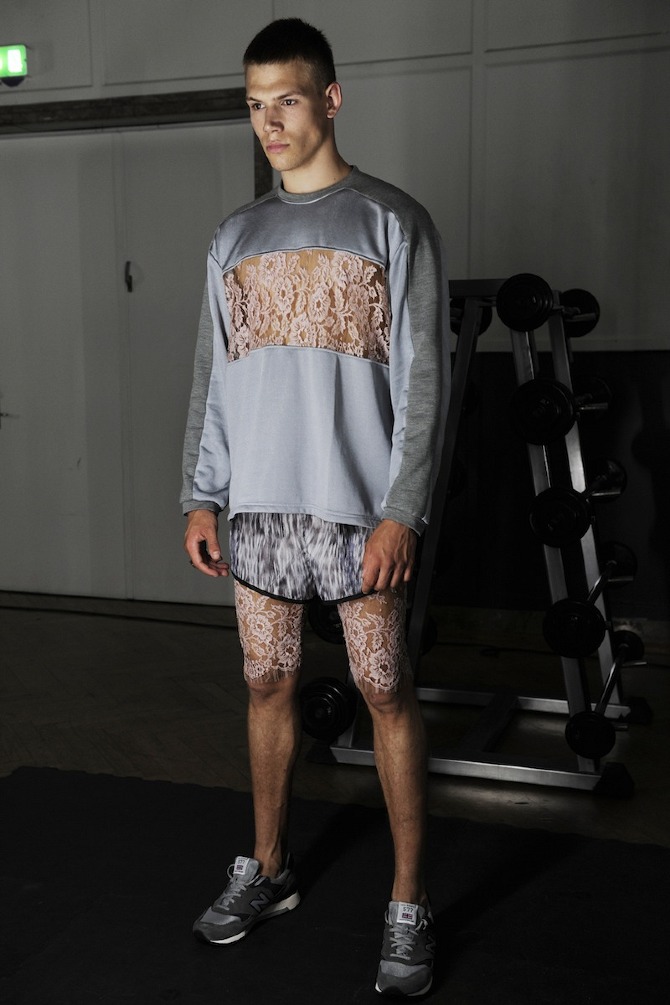There are fewer issues discussed more frequently
in the menswear industry than that of androgyny. Ever since Jean Paul Gaultier
chose male model Tanel Bedrossiantz as the face of his A/W 1987 womenswear
collection, the fashion industry has been bending gender roles and rewriting
the rules of masculinity. It’s widely-known that, in fashion, the concept of
androgyny is nothing new - Women have been wearing traditionally ‘male’ clothes
for decades, ever since Coco made it OK to wear trousers and Yves introduced
‘Le Smoking’. No headlines are made when designers include masculine tailoring
or boyfriend shirts in womenswear collections, and a simple Google search of
‘androgyny’ brings up countless images of stylish women dressed in their
boyfriends’ clothes. Women such as Grace Jones and Tilda Swinton made it
fashionable to take the lines of gender and blur them to the extreme; arguably
the only well-known male equivalent to these two women is David Bowie, who famously
indulged his androgynous side through a series of personas such as The Thin
White Duke and Ziggy Stardust. In summary, it seems that women now have
complete freedom when exploring the realms of androgyny and, now, the new
school of innovative London designers are working their hardest to secure this
same sartorial freedom for men worldwide.
 |
| Grace Jones - a pioneer of andr |
Perhaps the best example of male androgyny in
action is J.W Anderson, an Irish-born designer whose unusual silhouettes and
unorthodox fabrics caught the eye of the fashion elite. Since establishing his
eponymous label back in 2008, Anderson has gone on to create something of a
signature aesthetic, and it is one rooted firmly in androgyny. He talks
frequently about erogenous zones, quoting the collarbones and the nape of the
back as erotic areas which are rarely exposed. It is here that his silhouettes
take on deeper meaning – at first the cut-outs and exposed flesh seem to be a
mere design detail, yet they actually hint at vulnerability and present an
element of subversion. These elements of sexuality were more present than ever
in his Autumn/Winter 2014 presentation, known to many as the ‘sexy secretary’
collection. Based on call-centre workers, Anderson set his sights on taking the
banality of everyday uniforms and elevating them to high-fashion status – he
achieved this via a series of chunky platform heels, peplum jackets and tight
pastel knitwear that clung suggestively to the nipples. Many labelled the
collection as a controversial attempt to garner media attention and boost the
designer’s profile, a claim which he refutes. As opposed to a mere publicity
stunt, the collection appeared to be a conscious effort to re-open the dialogue
regarding androgyny for men. It highlighted the fact that men aren’t supposed
to be ‘sexy’ or ‘vulnerable’ – they are supposed, instead, to be powerful and
masculine.
 |
| J.W Anderson A/W 2014 |
Continuing this dialogue is designer Astrid
Andersen, a woman that also chooses to expose the men she sends down the
runway. However, in contrast to Anderson’s lithe, fresh-faced models, Astrid’s
boys are all athletes, comprised only of solid muscle. In some ways, her
casting choices are one of the most important aspects of her aesthetic as a
whole – she revels in the visual contradiction of dressing a huge hulk of a man
in a cropped pink floral. Although Andersen works mainly in the realm of
sportswear, she manages to incorporate androgyny by using mesh fabrics and lace
trims, as well as incorporating kimonos into her latest collection which looked
suspiciously like dresses. The genius of these ideas is that they aren’t at all
contrived – they aren’t a deliberate attempt to convey androgyny, they are
simply a byproduct of the collection’s Eastern sportswear aesthetic. They’re
also brilliantly wearable and serve as proof that no matter how ‘masculine’ the
model, it is still possible to incorporate androgyny without turning too many
heads.
 |
| ASTRID ANDERSEN Editorial |
Overall, the menswear industry is accelerating
at a faster pace than ever before. More designers are showing more collections
which means, inevitably, a wider range of aesthetics and more variation for
men. The rules are changing – hemlines on shirts are dropping to the extent
that ‘oversized’ now basically constitutes a dress, whereas traditionally
feminine prints such as lace and florals are being re-interpreted by designers
to cater to a male audience. As with anything, there is a spectrum of
outrageousness – it’s quite clear that the brand of androgyny that we see on
the catwalk will never become ubiquitous on the high street, so don’t expect to
see a host of men in your local Topman wearing floral crop tops. However, the
range of options means it’s now easier than ever for men to nod towards
androgyny without taking it to the extreme extent that high-fashion does. If
you choose to wear stacked-sole trainers, think of Anderson’s chunky heels. If
you choose to wear a mesh jumper, think of Andersen’s sportswear and
acknowledge that the runway is there only to plant the seed of an idea which
can then be incorporated into an everyday wardrobe. By following this
philosophy, we can ensure that the concept of androgyny will be one that
permeates the dress of men worldwide.
 |
| 'Miniskirts are back!' - Ada & Nik A/W 2014 |





No comments:
Post a Comment